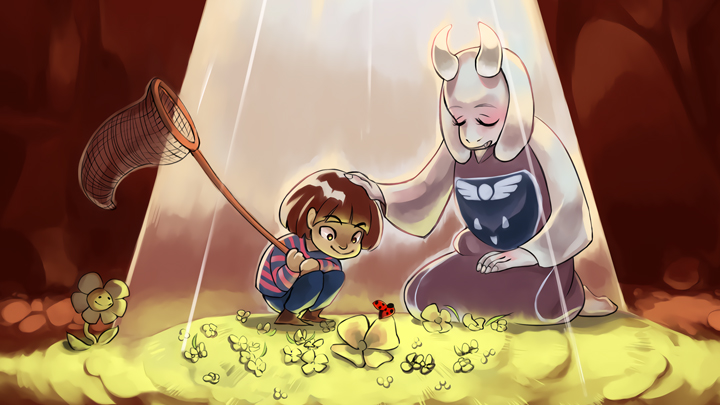Thanks to John Riccardi of 8-4 for providing a review copy.
There are games which need no introduction whatsoever. Games which you’ve either played many times from the beginning without getting tired of them or managed to avoid them until the hype died down and then played after opinions were long since been set in stone. This is one of those games. In any case, today I’m looking at Undertale, now on it’s third console port as it makes its way to the Nintendo Switch next week.
At this point, exactly three years after the original release (at the time of this review’s publication), you more than likely already know the plot to Undertale. But for the sake of those who don’t, a quick summary. Undertale is the story of a child who (somehow) falls deep into an underground world, full of monsters who had all been banished there by humanity so long ago. The child’s unexpected arrival puts the monster populace on edge, unsurprisingly. And after some interactions with both a shady flower known as Flowey and a friendly monster called Toriel, the child is thrust into the greater underground, determined to make their way back to the surface whilst unraveling the unknown aspects of the world around them. For the full experience, Undertale practically begs you go in blind, unspoiled. Most games do, really, but story driven ones like Undertale demand it, particularly given how mixed opinions can be towards how specific parts are handled.
The gameplay of Undertale is well documented in how it’s a large departure from other classic RPGs, namely those which heavily inspired it in the form of EarthBound and Mother 3. The core elements of an RPG, namely random battles, combat, experience systems and puzzles are all there. It’s the combat which differs so heavily. Avoiding attacks from an enemy is all about moving your soul, represented by a red heart, and dodging the attacks thrown at you, which can range from a simple matter of dodging to outright bullet hell levels of crazy. Retaliating involves one of two options: striking an enemy as normal with a target-like reticle for higher damage, or not attacking them at all and ending the fight peacefully by talking, playing or whatever option is available to spare a foe. Deciding how to proceed in battles has major effects later, particularly in the rest of the story, which is spurred on by the multiple endings, encouraging multiple playthroughs for the whole experience. It’s these mechanics intertwined with the plot that gives Undertale it’s famed replay value, making repeat playthroughs worthwhile for the sake of experimentation.
Though, since you’ve likely heard all of the above in practically every Undertale review out there, let’s switch gears and mention changes made to the game when transitioning to the Switch. And it’s about what you’d expect. The button prompts for the three commands you’ll ever use (action/confirm, cancel and menus) can all be rebound as you so desire, making the game compatible with pretty much anything except a singular Joy-Con (just for fun, I beat it to the end with an arcade stick myself). There are several differences in dialogue and interface given the PC to console transition, from minor and irrelevant to actual spoilers during key moments; the latter category are best experienced firsthand, as there is genuine surprise value for anyone only familiar with the original PC release (like me). Overall, Undertale’s transition from PC to Switch is very much seamless, much like its transition to the PS4 and Vita, keeping everything great about Undertale intact.
The previous point holds true for Undertale’s presentation, which continues to hold up. The graphics are admittedly as plain looking as they’ve always been and your mileage may vary on that, but elements like the music, backgrounds and UI still leave quite the impression, delivering on the aesthetic Undertale strives for. Much like the gameplay, nothing about the presentation has been lost in the transition. The sole major change, one shared with the PS4 version, would be the borders, a common sight when it comes to games with smaller native resolutions (think the recent Mega Man X Legacy Collection), but these are non-intrusive and even have several nice looking variants to choose from, more unlocked after beating the game, so it’s a neat bonus.
All the praise for the presentation would very much be unwarranted if the port was sloppily made…spoiler alert, it isn’t. The same care delivered with the other ports is present here, and Undertale on the Switch runs exactly like the original, with no stuttering or lagging. When you die, it won’t be the fault of any performance issues. And that’s how it should be in a game that frequently demands split second reactions.
In the end, what else is there to add to Undertale which hasn’t been said a million times over the last three years? Opinions vary on the way plot aspects are handled, and by extension some of their effects on gameplay, but that’s not the important part here. As a port of the 2015 original, Undertale on Switch is a fine experience, and whether you’re unfamiliar or already bought it so long ago, a $15 price tag won’t break your wallet (digitally, that is, given the physical and/or collector’s editions obviously going for much more), and you’re given one of the most unique RPGs in recent memory with great replay value.
Undertale on the Nintendo Switch releases September 18th.










It’s weird that this review ends with saying the game has “great replay value”, because I feel like the the game makes it clear that it DOESN’T want you to replay it, or rather reset everything. I mean, it does if you didn’t get the Good Ending, but after that, the game practically begs you not to undo everyone’s happy ending.